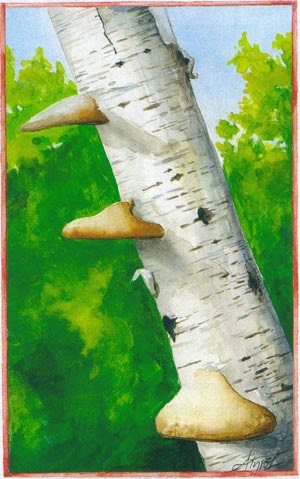
Also called birch bracket, this distinctive fungus only grows on birches, looks like nothing else that grows on birches, and is very common. Also in its favor from the human perspective is that it is not an aggressive tree killer, but is instead primarily in the business of decomposing dead trees. Birch polypore is present throughout the range of the birches, which grow around the globe in the northern hemisphere.
It is called a polypore because it used to be in a huge catch-all genus called Polyporus that included any non-mushroom-shaped fungus that produced its spores from pores, as opposed to gills or some other structure. Now these ex-Polyporuses have been parceled out into over 100 genera, Piptoporus being one, and further divided into several families.
The white-to-brownish fruiting bodies are annual, emerging from the bark of birches in spring and summer, but they deteriorate slowly and are still visible through the winter, though by then they have blackened and are not so attractive. Most fungal conks are woody and hard, but birch polypores have a leathery feel and an inflated look, as though a last breath from the tree had puffed them up a bit. The conks are attached to the tree by short, fat stalks. The smooth upper surface folds over at the outside edges, leaving a rounded rim around the flattened lower surface. The tiny pores that cover the lower surface are whitish when new, and up to a centimeter long, creating a large surface area from which millions of spores develop.
Perhaps a birch polypore gets its start many years before we see it, when a spore lands in a wound or a broken branch of a healthy host. Before the infection has a chance to spread, it is stopped in its tracks by the tree’s defense mechanisms and compartmentalized, to lie dormant for years until age or a downturn in fortune weakens the tree. At this point the ailing birch can no longer afford to maintain its defensive arsenal and the fungus revives and spreads.
By the time the puffy fruiting body emerges, decay is extensive. Wood rotted by the birch polypore is said to smell of green apples.
This is one of the few brown rotting fungi that exclusively attack hardwoods in nature, although in field and laboratory experiments pines, spruces, and poplars have been successfully infected. Brown rot fungi change but do not remove lignin; instead, they break down cellulose and hemicelluloses – the white, stringy components – leaving yellowish brown cubes. The birch recycling process is rapid, and this fungus can reduce wood density by 30 to 70 percent in just four months. After a few more months, the wood is very light in weight and can be crumbled to a powder in your hand. The interval between death and decay is, however, long enough for birds to excavate cavities in the softened wood and raise a family.
All fungi, previously believed to be a low form of life, are now considered to be more like animals than plants, and, like us, they manufacture compounds that are toxic to their enemies, most notably bacteria, that may either attack the fungus or compete with it for food.
The ability of fungi to manufacture antibiotics has been exploited by people long before penicillin was isolated from mold in the 1930s, beginning the modern antibiotic frenzy. Iceman, whose 5,300-year-old mummified body was revealed by melting ice in the Tyrolean Alps in Northern Italy in 1991, was packing a medicine kit complete with antibiotics. Tied to a leather thong was a lump of Piptoporus betulinus, which he is presumed to have used to fight bacterial infections. Nowadays, we humans exploit the fungal realm extensively in the commercial production of many hundreds of antibiotics.
Mushroom field guides call birch polypore “inedible,” some mentioning that it is bitter tasting despite having a pleasant, mushroomy smell. It has nonetheless long been used by herbalists, especially for making a tea from dried specimens that is believed to act as a restorative tonic.
Because it can be used in the final stages of sharpening knives and razors, it is also called the razor strop fungus. Like some other fungal conks, it will smolder for a long time and can be used to start fires.


Discussion *